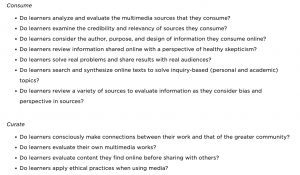What!?!? I Can’t Believe I Fell For That
With the internet and social media being a large part of our everyday lives it is important to have good digital literacy skills. A vital digital literacy skill that people need to have to stay safe online is to be able to recognize what is real and what is fake. Fake news is anywhere and everywhere when it comes to online platforms; there can be fake accounts, fake news articles, fake text messages trying to scam you, fake shopping sites, and so much more. This is why it is important to have some digital literacy skills before going online so that you do not get caught up in any of the fake online world to protect yourself.
Since the digital world is such a major part in majority of lives today, schools should be teaching their students digital literacy skills and how to be safe online. As I discussed in one of my previous blog posts (which you can take a look at here), there is nothing to be found in the Saskatchewan Curriculum that requires teachers to educate their students on being safe online and developing digital literacy skills. As many students use the online world I feel that teachers should spend time in their classes educating their students on how to be safe online and learn skills to help figure out what is fake or real when surfing the web. Although the curriculum does not straight out say to teach digital literacy, you can find other outcomes and indicators within other subjects that can be tied into incorporating digital literacy. To be specific in doing this is, you can use the goals outlined from the NCTE framework to incorporate through teaching the curriculum. This article takes ideas from the curriculum and ties it into how it is also used in the online world. For example, ‘consume, curate, and create’ is found largely throughout the English part of the curriculum and it can be tied into learning to be safe in the digital world. As seen in the image of the article below, they give a wide range of different questions that teachers can use to incorporate learning digital literacy through this part of the English curriculum.

They do not stop here they have put together so many other examples of how to incorporate digital literacy in other parts of the curriculum as well. If you are a teacher, this is a great resource to find ways to teach your students digital literacy while still teaching the curriculum! Some other resources that are helpful is Brake the Fake News, which is a quiz where you determine what is fake and not which you could play with your class as whole or in small groups, a worksheet that is great for teaching students that there is alway bias in every news article, another quiz where you determine what news headlines are fake or real, and more lesson ideas for teaching how to find if the news is fake or real.
I am doing my education degree for early elementary years, as I am hoping to be able to teach somewhere between grades 1 to 3. Although this age range may seem young, most of them have probably experienced playing, watching and being on technology. Therefore, I would still teach in these grade levels how to be digitally literate. I would do this by including in my daily morning meeting presentations a short digital literacy activity such as one of the fake news quizzes linked above. Another example I may include in my morning meetings with the students is in the morning meeting slide show we will be playing a game together on the smart board and then a fake, scam ‘text message’ pops up and then as a class we would discuss what we would do if this happened to us individually. This gives the an opportunity to teach the students that they should not answer messages or even open them if they do not know who they are from, rather show it to a parent or adult. There are so many different age appropriate little things you could incorporate into morning meetings that does not take much time away from other subject learning to have students think about and learn how to be safe online.
Do you like the idea of incorporating daily digital literacy learning through morning meetings? Have you found any other ways of incorporating digital literacy through the curriculum? Let me know your thoughts about digital literacy in classrooms in the comments, I’d love to hear your thoughts!